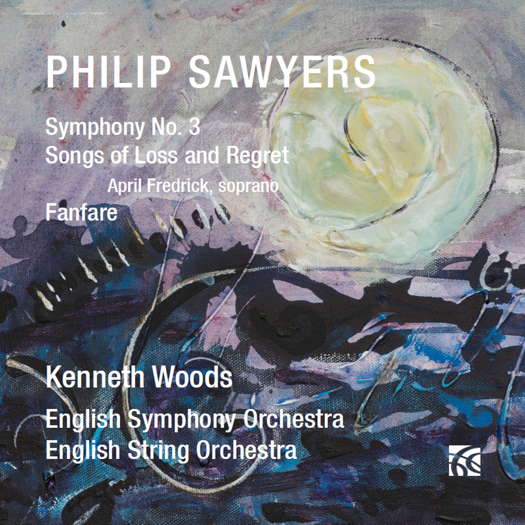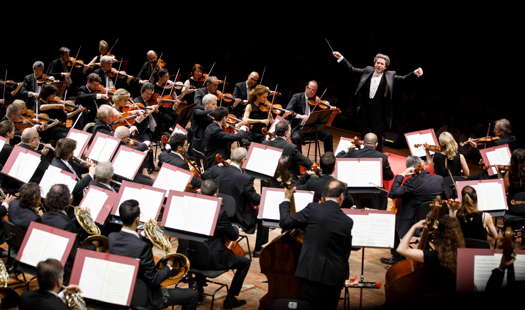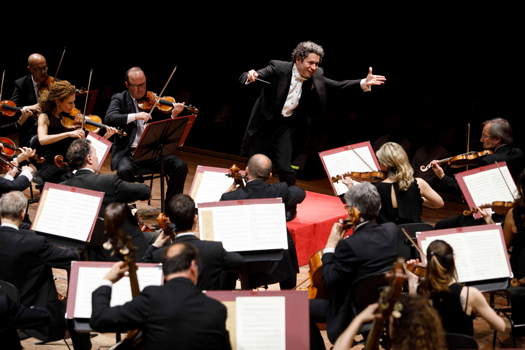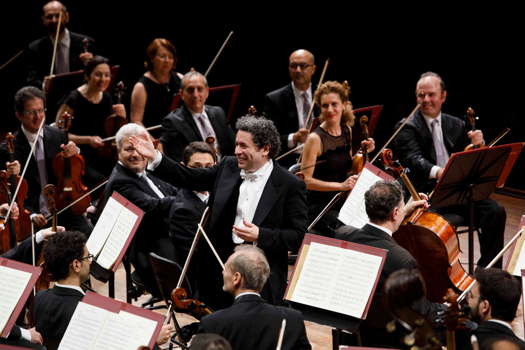- Hikaru Hayashi
- EuroArts
- Sadao Bekku
- Paul Creston
- Cecilia of Rome
- Satie: Gnossiennes
- Vazgen Gazaryan
- Curtis Opera Theatre
 SPONSORED: CD Spotlight. View from the Celli - Philip Sawyers' Symphony No 3 impresses Alice McVeigh.
SPONSORED: CD Spotlight. View from the Celli - Philip Sawyers' Symphony No 3 impresses Alice McVeigh.
All sponsored features >>
 DISCUSSION: What is a work? John Dante Prevedini leads a discussion about The performing artist as co-creator, including contributions from Halida Dinova, Yekaterina Lebedeva, Béla Hartmann, David Arditti and Stephen Francis Vasta.
DISCUSSION: What is a work? John Dante Prevedini leads a discussion about The performing artist as co-creator, including contributions from Halida Dinova, Yekaterina Lebedeva, Béla Hartmann, David Arditti and Stephen Francis Vasta.
Passion and Enthusiasm
GIUSEPPE PENNISI listens to
an all-Beethoven programme from
Gustavo Dudamel and the Orchestra of
the Accademia Nazionale di Santa Cecilia
The last concert of the National Santa Cecilia Academy 2018-2019 season was on 15-17 June; three performances as usual. I attended on 16 June 2019 - a hot and sunny summer Sunday when at least a quarter of Rome's population had gone to nearby beaches. Yet the large auditorium (designed for an audience of three thousand) was full. A determinant was the all-Beethoven program: Egmont Overture in F minor Op 84, Symphony No 4 in B flat, Op 60 and Symphony No 7 in A, Op 92. Thus, three favorite pieces for those who love traditional repertory.
The other determinant was the conductor, Gustavo Dudamel, Director of the Los Angeles Philharmonic for the last ten years and very much appreciated by both the orchestra and the audience. He conducted the Orchestra of the Accademia Nazionale di Santa Cecilia for the first time in 2005. Since then, he has returned to Rome a few times. However, his schedule is tight and busy. The last time, he conducted the orchestra was in 2013, when he left an excellent memory, also because, with his passion and enthusiasm, he develops a very strong empathy with both the orchestra and the audience. Thus, the younger and more innovative members of the audience are enthralled by him. Consequently, the mix of Beethoven and Dudamel is perfect to please everybody, and to convince Rome's residents to run to the concert hall rather than the beach.

Gustavo Dudamel conducting the Orchestra dell'Accademia Nazionale di Santa Cecilia
Dudamel's passion and enthusiasm were clear from the first piece of the concert: the ten minute Egmont Overture. Its three short sections (Sostenuto ma non troppo, Allegro and Allegro con brio) introduce a heroic drama about fighting and death for freedom. Dudamel conducted by heart, without a score (as he did for the rest of the concert) with a large arm and a solid baton, and in a vibrant and moving manner. Ten minutes of tensions and resolutions, where both the orchestra and the audience were elated.
I thought that both orchestra and audience would cool off with the often overlooked Symphony No 4, frequently overshadowed by Beethoven's Third and Fifth Symphonies. Generally, this work is considered cheerful, understanding and engaging, with a light instrumentation that recalls the symphonies of Joseph Haydn, with whom Beethoven had studied a decade before. Dudamel gave it a very interesting reading from the very B flat minor Adagio introduction to the first movement (which Leonard Bernstein described as a 'mysterious introduction which hovers around minor modes, tip-toeing its tenuous weight through ambiguous unrelated keys and so reluctant to settle down into its final B flat major'). Then, he emphasized with vigor the Allegro Vivace third movement, and increased the pace of the fourth and final movement, Allegro ma non troppo, which sounded like an outburst of joy.

Gustavo Dudamel conducting the Orchestra dell'Accademia Nazionale di Santa Cecilia
After the intermission, Dudamel conducted Symphony No 7, a perfect composition for his taste and style. The work is known for its use of rhythmic devices suggestive of a dance, such as dotted rhythm and repeated rhythmic figures. It is also tonally subtle, making use of the tensions between the key centres of A, C and F. The first movement, for instance, is in A major but has repeated episodes in C major and F major. In addition, the second movement is in A minor with episodes in A major, and the third movement, a scherzo, is in F major. The key element is the force that, as Sir George Grove wrote long ago, reigns throughout the symphony and explodes in the final Allegro con brio. Dudamel has force and energy to spare: he dragged both the orchestra and the audience with his strength, passion and enthusiasm. At the end, the ovations lasted about twelve minutes.

Gustavo Dudamel with members of the Orchestra dell'Accademia Nazionale di Santa Cecilia
This concert was a good conclusion to a real championship season. I have reported on some of the key concerts. The next season will start on 10 October 2019 with the monumental Grande Messe des morts by Berlioz, which calls for a chorus of 250, and will end in June 2020 with the final scenes of the three Tudor Queens operas by Donizetti, with Diana Damrau as soloist. Another championship season is in sight.
Copyright © 18 June 2019
Giuseppe Pennisi,
Rome, Italy



